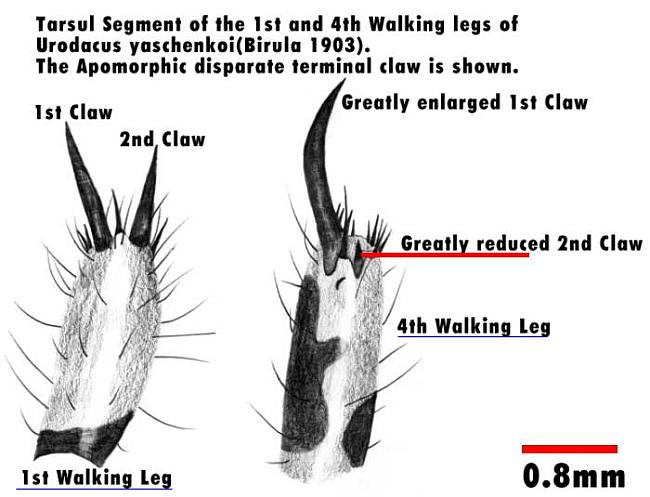
-Features-
An apomorphic character of Urodacus
Click Here to see 1st walking leg tarsus
The diagram above shows a sketch of the tarsul segments of the first and fourth walking legs. Clearly note the disparate development of the terminal claws of the fourth walking leg. The third walking leg(not shown) also shows a marked reduction of the second claw, although not to the same extent as the fourth.
This development has come about as a result of Australias drying out, creating a vast sandy environment, now very successfully inhabited by Urodacus yaschenkoi. The common ancestor of the genus Urodacus would have more than likey evolved in a mesic, temperate environment. Such species as Urodacus manicatus show mesic adaptation, this species may well be very close morphologically to the common ancestor of Urodacus and hence most likely displays minimal apomorphies.
As Australia dried out various new environments started to arise and the resulting speciation as we see it today would have begun in earnest. Those animals such as Urodacus yaschenkoi have managed to evolve the necessary features to survive in the xeric environment as we see it today, a far cry from the temperate rainforests once covering Australia.
The terminal claws as shown above have evolved to give the animal increased traction in a very loose sandy environment. Urodacus that dig in hard compacted soil often do not display the disparate claw lengths as shown, but have maintained this feature as the plesiomorphic character of the common ancestor. Such apomorphies arise out of environmental selection pressures. Urodacus yaschenkoi is at the extreme end with respect to apomorphies having evolved to cope with xeric conditions. Various intermediate forms of arid and xeric adapted Urodacus have evolved across Australia, all exhibiting similar apomorphies at various levels.
|